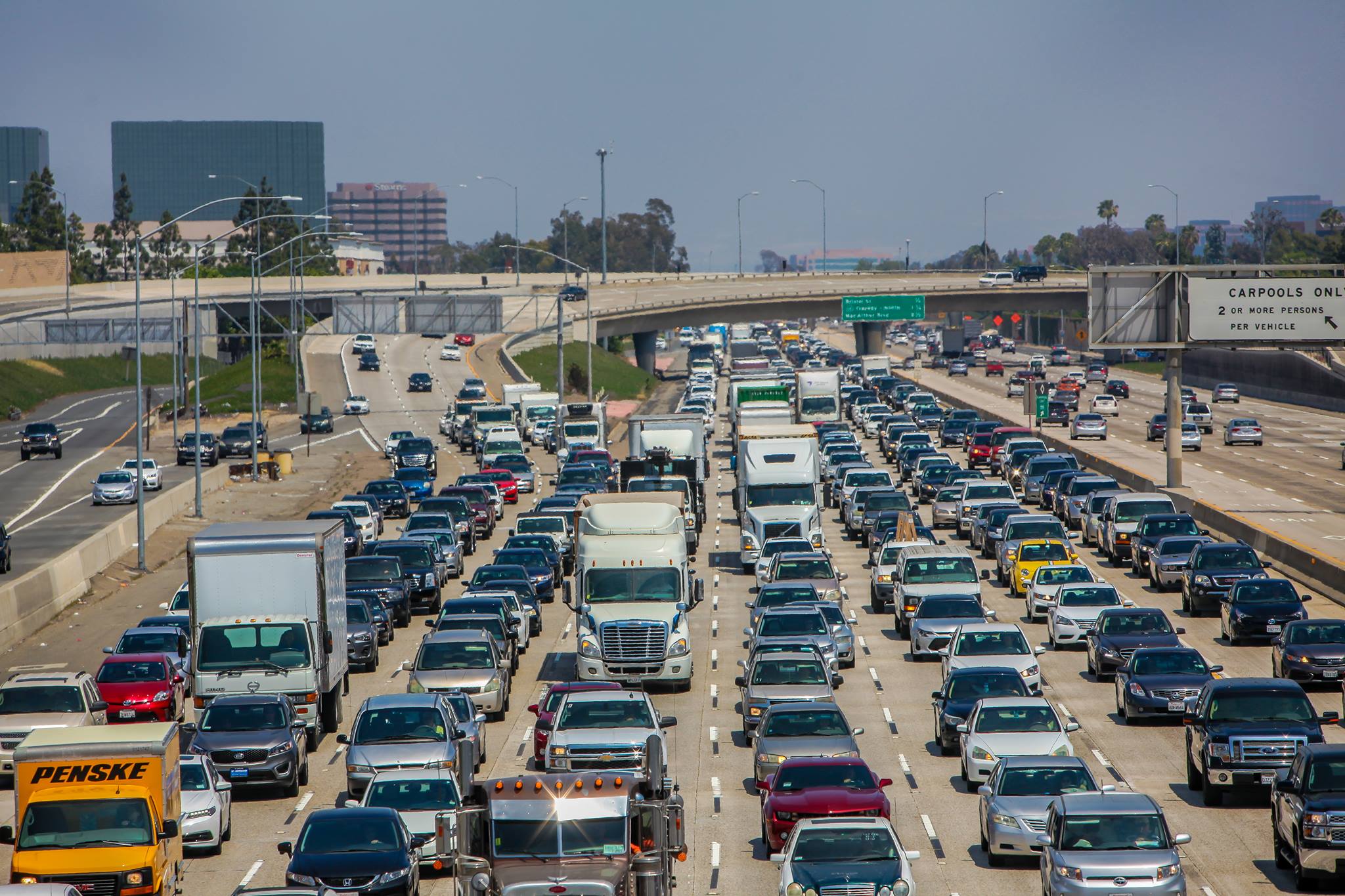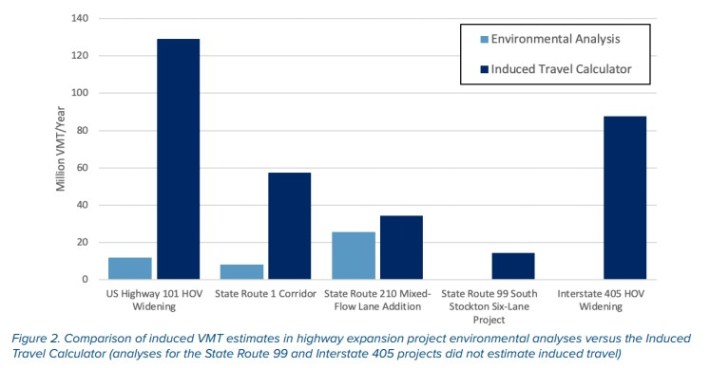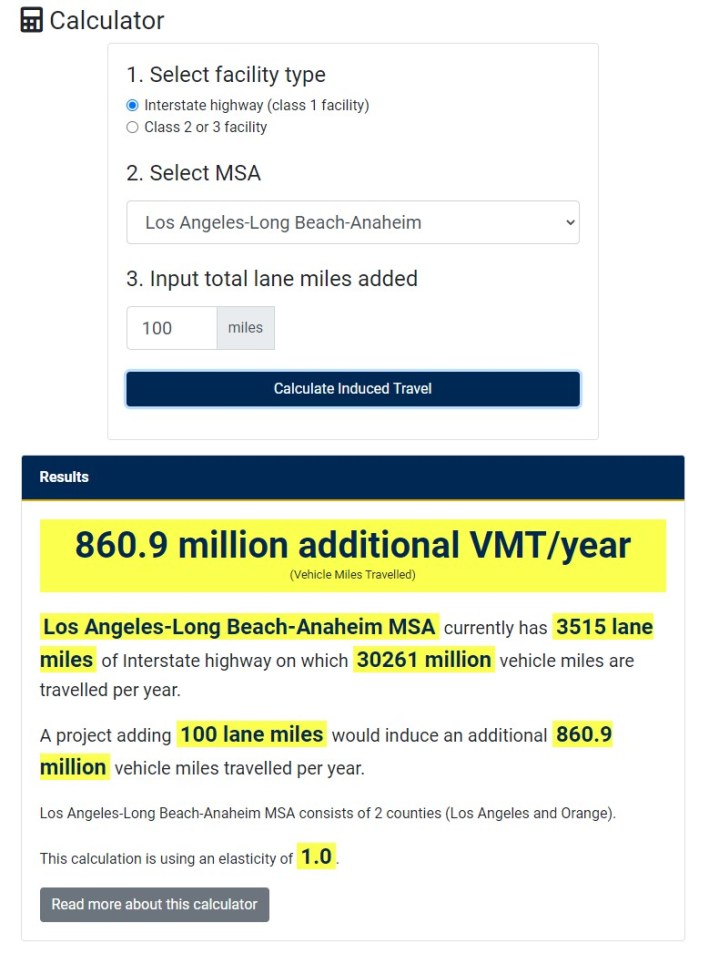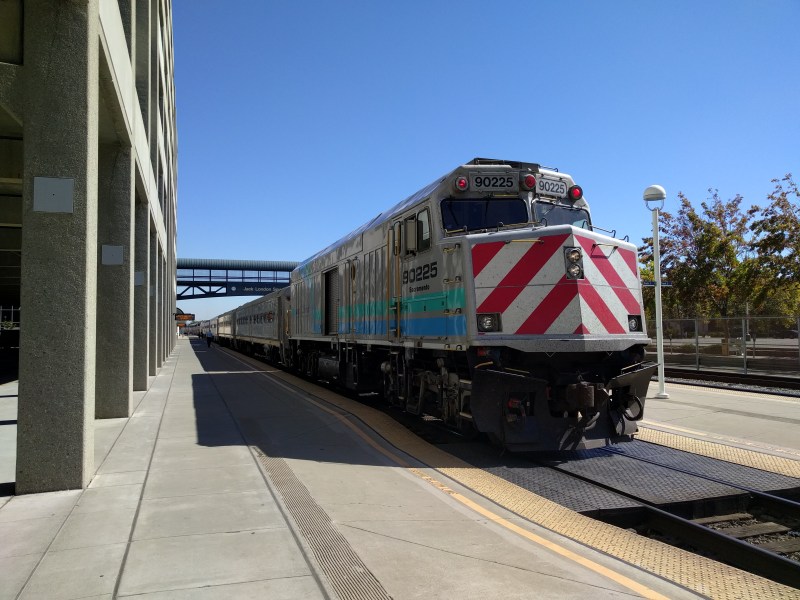Interview: California Freeway Expansion Projects Induce Travel, and Underestimate Impacts of Additional Driving
12:53 PM PST on February 17, 2021

405 Freeway in Orange County – photo via Caltrans
Last year, three UC Davis scholars published a paper, titled Induced Vehicle Travel in the Environmental Review Process, which explored how several California freeway expansion project analyses failed to fully account for the additional driving (Vehicle Miles Traveled - VMT) that resulted from these projects.

The authors state that induced travel is often "ignored, underestimated, or misestimated in the planning process, particularly in the assessment of the environmental impacts of roadway capacity expansions." This, they say, leads to overestimating any traffic congestion relief that may come from a highway expansion, as well as underestimating its environmental impacts.
The authors created a publicly-accessible online tool, an Induced Travel Calculator, to estimate how much driving a highway expansion project in California will induce. Anyone can input the number of planned new roadway lane miles and the calculator will estimate the new driving anticipated to result. For example, in the L.A. region, each new lane-mile can be anticipated to induce an additional 8.6 million vehicle miles traveled (VMT) per year. City Observatory recently calibrated the calculator for a freeway expansion proposed in Portland, Oregon. City Observatory notes that greenhouse gas emissions relate directly to VMT (generally, 1,000 miles driven produces ~0.466 tons of greenhouse gases), so the calculator can be used to estimate climate change impacts of roadway expansions.
The UC Davis paper received the Mary Nichols Environmental Policy Award. The full paper is behind a paywall, but the abstract is viewable and the findings are summarized in a policy brief.
The paper's authors are:
- Susan Handy, professor in the Department of Environmental Science and Policy and director of the National Center for Sustainable Transportation
- Jamey Volker, postdoctoral scholar with the National Center for Sustainable Transportation and an environmental lawyer
- Amy Lee, PhD candidate in the Transportation Technology and Policy program
Streetsblog contacted the authors to get their take on how induced travel can impact ongoing analyses and projects. The interview below was conducted over email earlier this month.
Many urbanist writers use the term "induced demand," though you use "induced travel." Are these the same? Why do you use the term you do?
“Induced travel” and “induced demand” are commonly used interchangeably to describe the same phenomenon, but they are technically different concepts.
Induced travel is the broader term, describing any increase in vehicle miles traveled (VMT) attributable to an increase in roadway capacity.
Induced demand is just one component of induced travel. In the language of economists, induced demand is where the demand curve shifts – where new demand for driving is created by people or businesses moving to an area to take advantage of increased roadway capacity and the resulting (yet temporary) increase in mobility and reduction in congestion. Induced travel includes both induced demand (demand curve shifts) and supply curve shifts – where increased roadway capacity in an area causes people already in the area to drive more (the demand is already there, but the lower cost of driving enables more of it to be satisfied).
For example, if Los Angeles added lanes to I-405 or other major roadways, it would likely increase the speed of traffic on those roadways, at least initially. That reduction in congestion (a lower “cost” of driving) could both (1) cause people to move to Los Angeles (induced demand), and (2) cause existing Angelenos to make more trips by car, drive longer distances, or otherwise increase their VMT. The induced travel from the I-405 expansion would include the combined increase in VMT from both the new Angelenos (induced demand) and the existing Angelenos.
Induced travel has been observed and known for a long time. But so many folks - from transportation agency staff to public works directors to elected officials - still ignore or fail to acknowledge or understand it. For example, Caltrans has claimed that widening the 5 Freeway will "reduce congestion" and "decrease surface street traffic." Do you have any sense of why agencies and the general public have been so slow to acknowledge induced travel?
This question is worth a study of its own. In talking to various folks, there seem to be at least three factors.
First, it is deceptively easy to view traffic congestion as a static problem. When you’re stuck in stop-and-go traffic, it’s easy to visualize how traffic would speed up if there were just another lane to spread the cars across. And in the short term, you’d be right – expanding roadway capacity generally does reduce traffic congestion and increase travel speeds in the short term (not counting the significant delays that can occur during construction). It’s much harder to conceptualize the dynamic aspect of traffic congestion – the longer-term behavioral changes that occur in response to changes in roadway capacity. As a result, the short-term benefits often end up masking the longer-term induced travel effect, both in the public’s eye, the policymaker’s political calculus, and the analyst’s cost-benefit evaluation.
Second, induced travel is not easy to measure. One of the most challenging issues is disentangling cause and effect – do roadway expansions actually induce additional vehicle travel, or merely respond to growing demand for driving? Over the last couple decades, researchers have developed sophisticated methods to control for this bidirectional relationship and isolate the induced travel effect. And the studies have come to remarkably consistent conclusions about the magnitude of the effect – in the longer term (within five to ten years after construction), VMT tend to increase commensurately with the magnitude of the capacity expansion for highways and other major roads. That is, a one percent increase in highway lane miles would “induce” a one percent increase in VMT after five to ten years.
However, these increasingly consistent results have not yet translated into common transportation planning practice. One reason is that the primary tools used to evaluate the effects on travel of proposed roadway projects – travel demand models – generally do not fully account for induced travel. Another reason is that the induced travel studies use data aggregated across large regions, as is generally required for the statistical methods necessary to estimate the induced travel effect. That gives proponents of any specific roadway expansion project the opportunity to say “well, the local context here is different, so the average effect from the academic studies doesn’t apply”; it affords a veneer of plausible deniability.
Third, the primary performance metric for roadway projects over the past fifty-plus years has been automobile level of service (LOS). That metric prioritizes projects that increase traffic speed and volume. Most roadway expansion projects will improve LOS, at least initially, even if you account for induced travel. As a result, there has been less impetus to estimate induced travel during the review process for roadway projects. But that is changing in California, where VMT recently replaced LOS as the primary measure of transportation impacts under the California Environmental Quality Act. Caltrans has leaned into that shift. In September 2020, it published its first ever Transportation Analysis Framework, in which it emphasizes the importance of reducing VMT from projects on the state highway systems. The Framework guides transportation impact analysis for state highway system projects under CEQA [the California Environmental Quality Act], and it recommends that NCST’s [UC Davis' National Center for Sustainable Transportation] Induced Travel Calculator be used where possible to estimate – or at least benchmark – induced VMT.
As your paper touches on, many environmental studies don't acknowledge that induced travel exists. It seems like generally traffic analyses are based on Level of Service (LOS), which pretty much inherently denies the existence of induced travel. Do most environmental analyses completely ignore induced travel? When and how is it included in environmental studies?
In our study, we reviewed the CEQA environmental analyses for five highway capacity expansion projects in California. We found that the analyses varied wildly in their discussion of induced vehicle travel. Two of the documents did not discuss the induced travel phenomenon at all. And the only two documents to analyze induced travel in detail did so in responses to comments from the public, not in the original analysis. Even when the documents did analyze induced travel in detail, the discussion was internally inconsistent and also inconsistent with the induced travel literature. In terms of actual quantification, only three of the five analyses attempted to estimate induced VMT. All three estimates were lower than what we estimating using the Induced Travel Calculator.
We would not say that the concept of Level of Service inherently denies the existence of induced travel. The problem is that LOS is almost always calculated based on estimates of VMT that do not account for induced travel.
Your paper includes analyses of the 405 Freeway widening in west Los Angeles. Please share some of what you found regarding that project. Perhaps include how much induced travel was predicted - and how much actually resulted?
The draft environmental review document for the I-405 project did not discuss or analyze induced travel. In response to comments, the final document discussed induced travel, but it neither estimated how much VMT the project would induce nor acknowledged that the project could generate additional vehicle travel. We estimated using the Induced Travel Calculator that the I-405 widening project would induce 87.8 million VMT per year.
Your paper features an online tool for calculating induced travel. Could you describe the basics of the model to Streetsblog readers? Can cities/agencies just start using your model in new environmental studies?
We developed an online tool – the Induced Travel Calculator – to help agencies estimate the VMT induced annually by adding lanes to major roadways in California’s urbanized counties (counties within metropolitan statistical areas). The Induced Travel Calculator estimates project-induced VMT using the project length entered by the user, regional lane-mile and VMT data from Caltrans, and estimates of elasticities (the percentage change in VMT that results from a one percent increase in lane-miles) from peer-reviewed studies. The Calculator is freely available for use here.

It seems like ignoring (or underestimating) induced travel makes environmental analyses inaccurate and wrong. Do you think that this could have legal implications? Could communities challenge these freeway expansion project Environmental Impact Reports (EIRs) for being wrong?
The empirical evidence shows that expanding the capacity of roadways – at least freeways, highways, and major arterials in metropolitan areas – induces VMT. It’s not merely a hypothetical impact. Induced travel will often be the largest source of project-related VMT.
So yes, if the CEQA analysis for a roadway expansion project omits this important component of the project’s VMT impact, it could be vulnerable to a CEQA lawsuit.
One caveat is that the CEQA guidelines give agencies discretion to choose the best measure of transportation impacts for roadway expansion projects – it does not have to be a VMT-based standard. But agencies should not ignore induced travel even if they decide to retain an LOS-based transportation impact standard. Project-induced VMT affects multiple other categories of environmental impacts that agencies must analyze and mitigate, like air quality and climate change. For its part, Caltrans has adopted a VMT-based approach that recognizes the importance of measuring induced travel.
L.A. Metro staff have stated that most of their highway projects "don't affect vehicle miles traveled or greenhouse gas emissions because they’re focused on specific locations where congestion already exists." Further that they're just focused on "current deficiencies such as bottlenecks, design deficiencies, accident rates, and other factors resulting in choke points.” Is it possible to address existing congestion, bottlenecks, deficiencies, etc. without inducing travel?
In general, you’re going to see the highest rates of induced travel and more total induced VMT when expanding roadway capacity in congested areas, areas with “bottlenecks” or unsafe roads, or areas with minimal accessibility. It’s generally in those areas that you will see the greatest short-term reduction in travel time after a capacity expansion. That initial reduction in the time cost of driving is what spurs the increase in driving and VMT.
The empirical evidence shows that expanding the capacity of freeways, highways, and major arterials in metropolitan areas induces VMT in close proportion to the expansion within five to ten years after construction, causing congestion to return to close to pre-expansion levels. Expanding roadway capacity has not proven to be an effective strategy for relieving congestion in the long term.
In Southern California, Metro and Caltrans are still moving forward with plans to widen freeways, including the 710, 605, and 5 Freeways. What sort of induced demand should Angelenos expect from these projects?
We haven’t run the numbers for these projects, but we encourage interested Angelenos to find out for themselves using our Calculator.
In L.A., traffic congestion is bad, so there is pressure - on cities, agencies, elected officials - to "do something." What's your advice to decision-makers looking to "do something" about traffic?
The first step is to have an honest conversation with the public about the true impacts and costs of expanding roadway capacity, i.e. increased VMT and little to no congestion relief in the long term. It’s also important to recognize that congestion is an indicator of high accessibility to desired destinations – congestion is not all bad. Research from UCLA indicates that proximity is much more important than travel speed in determining opportunities to access jobs in the L.A. metropolitan area. Increasing densities will increase congestion, but it will also increase accessibility – more opportunities available within a given time shed.
Of course, even with greater accessibility, drivers in congested areas will still prefer less traffic. There are ways to reduce that congestion – or at least keep it from worsening – without increasing roadway capacity. On the demand side, pricing road use and parking closer to market value can help. On the supply side, expanding or improving public transit and active transportation options can help, especially when paired with demand-side measures. Measure M’s transit and active travel funding is a good example of the supply-side approach. It would be more effective in reducing VMT if paired with demand-side measures. But demand-side measures tend to be more politically onerous to implement – you’re making something more expensive, rather than providing a new or better service.
Both supply- and demand-side measures also risk perpetuating existing inequities in transportation costs and general accessibility to goods, services, and jobs for lower-income communities and communities of color. But so does expanding unpriced roadways. A 2018 study by UCLA professor Michael Manville and Cornell lecturer Emily Goldman in the Journal of Planning Education and Research found that “free urban highways primarily subsidize richer people, and the resulting congestion creates pollution that disproportionately burdens poorer people.” The authors further concluded that the revenue generated by congestion pricing "could compensate any poor drivers harmed.” Regardless, both supply- and demand-side measure approaches to reducing congestion must be taken cautiously and with community partnership.
Read More:
Stay in touch
Sign up for our free newsletter
More from Streetsblog California
Tuesday’s Headlines
Silicon Valley's transit market ready to grow; CA can't afford NOT to build better bikeways; Slower speeds mean fewer deaths; More
The E-Commerce Explosion is Making Roads More Dangerous
And can advanced technology stop the bloodshed?
No, L.A. City Does Not Always Add Required ADA Ramps During Resurfacing, But They Should
StreetsLA GM Keith Mozee "Any time we do street resurfacing, it is considered an alteration, which requires ADA ramps to be installed."
When it Comes to Federal Infrastructure Grants, Size Does Matter
Cities and municipalities with larger budgets and staff are more likely to win competitive federal infrastructure grants, the Urban Institute has found.
Update on Oakland DOT’s Lakeshore Protected Bike Lane Project
Public seems fairly positive and accepting towards the coming project. Let's hope it stays that way




